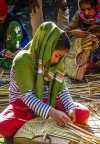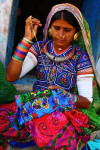Origin, Significance, and History
Sohrai Painting was discovered first in Jharkhand, Hazaribagh district. The art is done in the form of wall painting during the Sohrai festival, to celebrate after harvest. Sohrai art is regarded as the oldest and most famous festival in Jharkhand, Bihar, Chhattisgarh, Odisha, and West Bengal. The term 'Sohrai' is derived from the paleolithic word 'Soro' which defines 'to drive with a stick'. The theme of Sohrai art is based on Nature, Animal, Human, Forest, which is usually performed by the tribal women using elements like charcoal and clay. The art form dates back to a long time ago from 10,000 to 4000 BC. According to old Mythos, the God of Mountain named Marang Buru, Goddess of Forest Jaher Ayo, and Santhal's elder sister would come down to earth to see their brother. The harvest festival is observed to glorify and worship this event.
The festival is observed mainly to appreciate goats, sheep, bullocks, and buffalos. The Sohrai art form which is performed during the festival is to celebrate fertility after harvesting is completed. The walls are portrayed with different designs of animals and birds.
Techniques and Materials Used
Firstly, while performing Sohrai art the walls are varnished with coats of white coloured mud. Then before the wet mud can dry; they draw illustrations on walls using their fingers, broken comb, or tooth-sticks which are usually chewed. Cow dung is often used for colouring the walls. The tribal people also use pieces of clothes drowned in varied earth colours to paint the walls.
The wall art is done with the help of colours obtained naturally and mixed with mud like Kali Matti, Duddhi Matti, Charak Matti, Lal Matti, and Pila Matti. The whole process is continued in the same way in both the cases of colourful or monochromatic painting.
Current Scenario of the Artists
The glorious art form of Jharkhand is continuously being witnessed diminishing day by day, in the past years and the artists failed to get the respect they deserved. Initially, artists struggled a lot for their living and recognition. Presently, their lives have evolved a lot and turned into a better place. A drastic change has occurred, due to the improvement in technologies and promotion of Sohrai art by the State government. The Sohrai art was also rewarded by, Geographical Indication Tag. The artists of Sohrai art are currently honoured at the National level and in countries such as Australia, Germany.
Current Position of the Art
The oldest ritualistic State art of Jharkhand, named Sohrai has presently gained a lot of recognition and honour. Though wall painting in the form of Sohrai is altered with cement and brick plaster. But the department of culture and state is currently engaged in giving opportunities to the tribal artists to draw in the walls of Hazaribagh and Jamshedpur Railway station, government building, and airport with beautiful traditional Sohrai Art. Through this, the state is trying to ensure maximum audiences for all the Sohrai Artists. This step taken by the state government has helped the artists to gain more and gather courage and self-confidence among themselves. The Corporates of Tata Steel has also helped the artists to achieve their identification by promoting the past culture and keeping it alive.
Recently, the Sohrai Khovar painting in Jharkhand has been honoured with the Geographical Indication (GI) tag by the registry of Geographical Indication. Sohrai Kala Mahila Vikas Sahyog Samiti Limited made the Geographical Identification Tag for the Sohrai Khovar art in Jharkhand.
Sohrai Artist
The best attribute of Sohrai painting is that it is passed on as heredity from a mother to a daughter who grows observing her mother drawing on walls.
A young girl named Putli Devi who was born and brought up in Hazaribagh, saw her mother doing Sohrai art on walls, and learned the art steadily. Putli grew up to be an amazing Sohrai Painter, but her art was never recognized. But currently, Putli Devi is successful in showcasing her art in Australia and Germany.
Bulu Imam is known for upholding the spirit of wall painting, where he documents native culture and tradition in Jharkhand. He ensures that the modern generation should be aware of the rich history, its art, and culture through Sohrai Wall Art.
Sohrai Painting is regarded as the state art of Jharkhand and forms a major value in the culture and tradition of the state. The art form has a secular and religious value as it is performed fully by women and promotes their empowerment. Sohrai art should be preserved and promoted in different countries to prevent creative art from getting endangered.
Picture Source: vajiramIAS



